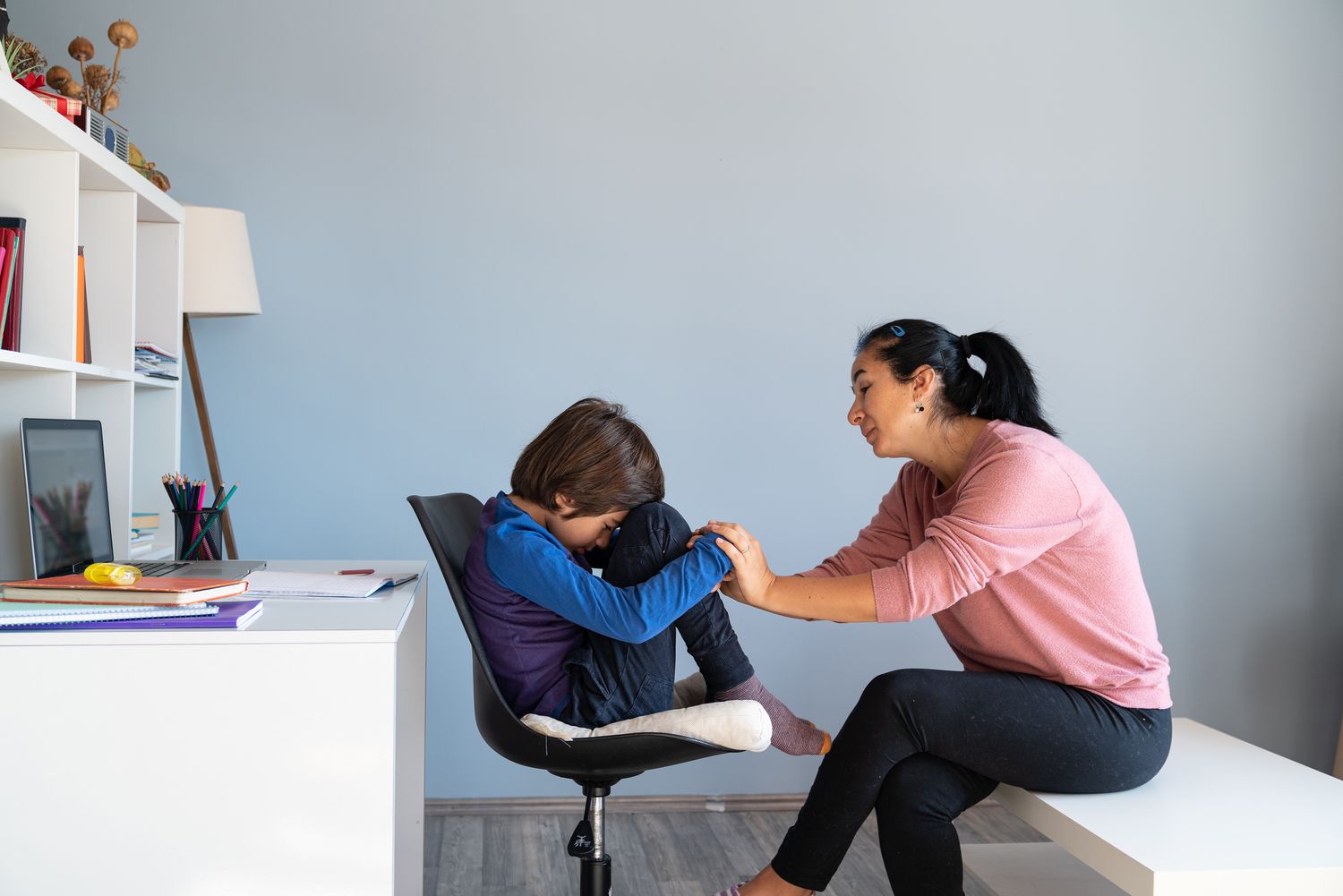子育てをしていると、子どもの不安と向き合う場面は少なくありません。入園や入学といった新しい環境に対する不安、友だちとのトラブルや習い事での緊張、あるいは将来への漠然とした心配など、子どもが抱える不安には多様なケースがあります。大人から見れば些細なことに思えても、子どもにとっては真剣に悩ましい出来事であり、日常生活に大きな影響を及ぼす場合もあるのです。
子どもが不安を抱えたとき、親としては「何とか安心させてあげたい」「早く笑顔になってほしい」と願います。しかし実際には、どう接すればよいのかわからず、余計な一言で不安を強めてしまったり、過剰に励まそうとして逆にプレッシャーを与えてしまったりすることも。そこで本ブログでは、子どもの不安を和らげるための「コミュニケーション術」をテーマに、その考え方や具体的な方法をお伝えしていきます。親子の絆を深めるヒントとして、ぜひ参考にしてみてください。
1.子どもが不安を抱える理由
私たち大人でも、新しい職場に移ったり、慣れない作業を任されたりすると不安を感じますよね。子どもは大人よりも経験や知識が少ない分、自分の中で起きていることをうまく言語化できない場合が多いのです。たとえば、新しいクラスで友だちができるかどうか、先生はどんな人なのか、周りに迷惑をかけないか――そうした不確定要素が多いほど、不安は大きくなります。
また、子どもは大人に比べて自尊感情がまだ十分に確立されていないことがあります。少しの失敗や友だちの一言が大きなショックとなり、「自分はダメなんだ」と極端に落ち込んでしまうケースも珍しくありません。さらに、親や保護者の言動や表情から不安を察知し、負の感情を一緒に背負い込んでしまうことも。子どもの不安は、単に「怖がりだから」という一言で片づけられるものではなく、複雑な要素が絡み合って生じることを理解しておきましょう。
2.不安を和らげるための基本的な姿勢
(1) 受け止めることから始める
まず大切なのは、子どもの不安を「大したことない」と否定したり、「そんなの気にしなくていい」と軽く扱ったりせず、一度しっかり受け止めることです。不安を感じている子どもにとって、親にすら真剣に話を聞いてもらえなかったら、「理解してもらえない」「自分の気持ちはないがしろにされている」とますます不安が強まる可能性があります。たとえ親から見て小さな悩みに思えても、子どもの世界では深刻な問題であることを尊重しましょう。
(2) 無理に励まさない
不安を抱える子どもに対して、親はつい「大丈夫だよ」「頑張れ」と言いたくなるものです。もちろん励ますつもりの言葉なのですが、これがかえって「自分の不安は軽く見られている」「ちゃんとできていないのに頑張れと言われるのがつらい」という風に伝わる場合があります。子どもが本当につらいと感じているときは、まず「つらいね」「不安だよね」と、その感情自体を肯定する言葉かけを心掛けると良いでしょう。
(3) 親の感情を安定させる
子どもは親の表情や声のトーンに非常に敏感です。親が焦りや苛立ちを見せてしまうと、子どもは「こんなことで親を困らせてしまった」「自分のせいで大変なことになっているのでは」と、不安が一層深まる可能性があります。子どもの不安を和らげるには、まず親自身が落ち着いた心持ちで接することが大切です。深呼吸をしたり、一度席を外してクールダウンしたりして、冷静な姿勢を保つことを意識してみましょう。
3.子どもの不安を和らげるコミュニケーション術
(1) 「傾聴」と「共感」の基本
子どもの話を聴くときは、できる限り相手の目線まで姿勢を合わせ、うなずいたり相槌を打ったりして、「あなたの話をちゃんと聞いているよ」というサインを伝えることがポイントです。特に不安な気持ちは、言葉にするだけでいくらか軽くなるもの。子どもが言葉に詰まったときは、「焦らなくていいよ」「ゆっくりでいいよ」と声をかけて、言葉を引き出すサポートをします。共感は「それは怖かったね」「そりゃ緊張するよね」と、子どもの感情を認める表現を用いるとよいでしょう。
(2) 質問で気持ちを整理する
ただ「大丈夫?」と聞くよりも、もう一歩踏み込んだオープンな質問を投げかけるのも有効です。たとえば「どういうところが特に不安なの?」とか「それをどう乗り越えたいと思う?」といった質問は、子どもが自分の気持ちや状況を整理するきっかけになります。子どもは自分で理解できない不安要素を抱えていることが多いため、言葉のサポートを通じて少しずつ意識化することが、不安軽減の一歩になるのです。
(3) 具体的な対策を一緒に考える
不安は「わからない」「予想できない」という状態から生まれるケースが多いです。そこで、子どもが具体的な行動や準備をイメージできるように一緒に考えることが効果的です。たとえば、幼稚園で新しい友だちができるか不安な場合、「初めて話しかける時は何て言えばいいかな?」「先生に相談できそう?」など、具体的なシミュレーションを通じて「やってみるイメージ」を持たせることが大切です。子どもの意見を聞きながら、一緒に小さなステップを組み立てていきましょう。
(4) ポジティブな側面に目を向ける
不安に焦点が当たりすぎると、気持ちまでネガティブになってしまいがちです。話を聴ききったうえで、「でも〇〇ちゃんはこういう良いところがあるよね」と、子どもの強みや前向きな経験を思い出させてあげましょう。たとえわずかでも過去に成功した体験や「できた」瞬間を思い出すことで、「また頑張れるかもしれない」という気持ちが自然と湧いてきます。
4.不安を減らすための生活習慣や環境づくり
(1) 安心できる日常のリズムを整える
子どもの不安が増大しやすい要因の一つに、生活習慣の乱れや睡眠不足があります。早寝早起きや適切な食事、遊びと休息のバランスなど、基本的な生活リズムを安定させることで、不安を感じにくい土台を築くことができます。また、寝る前に家族でゆっくり会話をする時間を作ったり、翌日の予定を親子で確認したりすると、「明日はこう動くんだ」という安心感が育ちやすくなります。
(2) 安心できる場所や人を確保する
家の中でも自分の好きな場所や落ち着けるスペースがあると、子どもはそこを「安全基地」として利用しやすくなります。お気に入りのぬいぐるみやブランケットなど、子どもが心を落ち着けられるアイテムを用意してあげるのもよいでしょう。また、家族以外にも先生や親戚、近所の人など、信頼できる大人がいる環境は、子どもの不安を外部からもサポートしてくれます。
(3) 親子で楽しめる時間を作る
日常が忙しいと、どうしても「早くしなさい」「宿題は終わった?」といった声かけが増え、コミュニケーションが義務的になりがちです。しかし、不安を和らげるには、親子でリラックスして過ごせる時間が欠かせません。一緒にゲームをしたり散歩をしたり、本を読んだりと、ほんの少しの時間でも「楽しい」「安心できる」と感じられる経験が、子どもの心を支える大きな柱になります。
まとめ
子どもが不安を抱えたとき、その気持ちを解消してあげたいと願うのは親として当然の思いでしょう。しかし、不安は悪い感情ばかりではなく、成長や学びの機会につながる場合もあります。大切なのは、その不安とどう向き合うかです。
今回ご紹介した「子どもの不安を和らげるコミュニケーション術」は、まず子どもの話をしっかり聴き、共感し、安心できる環境を整えるというシンプルな考え方がベースにあります。そこに少しだけ質問の仕方や声かけのポイントをプラスするだけで、子どもが自分の不安を整理し、乗り越える力を引き出す手助けができます。
もちろん、親も完璧ではありません。ときには自分自身が疲れていて、子どもの不安を受け止める余裕がない日もあるでしょう。そんなときは、周囲の大人や専門機関にサポートを求めてもかまいません。子育ては一人で抱え込むものではなく、家族や地域、社会全体で支え合っていくものです。
子どもの不安を一緒に乗り越えていくことは、親子の関係をより深く、よりあたたかなものにしてくれます。どうか、日々の小さなコミュニケーションの積み重ねを大切にしながら、子どもと一緒に笑顔の時間を増やしていってください。
Communication Techniques to Ease a Child’s Anxiety
When raising children, situations that involve confronting your child’s anxiety are not uncommon. Whether it’s apprehension about a new school or preschool, nervousness about interacting with friends or in extracurricular activities, or even general worries about the future, children experience various forms of anxiety. What may seem trivial from an adult’s perspective can be a serious concern in a child’s world, sometimes significantly affecting their daily life.
When a child is anxious, parents naturally wish to reassure them, to see them smile again. However, it can be challenging to know how to respond effectively. Sometimes an offhand comment might worsen the anxiety, or over-enthusiastic encouragement could end up adding pressure instead of relief. In this blog, we focus on “communication techniques” that can help reduce a child’s anxiety. I hope you find these suggestions useful for strengthening your bond with your child.
1. Why Do Children Feel Anxious?
Even adults feel anxious when starting a new job or facing unfamiliar responsibilities. Children, having less experience and knowledge, often find it difficult to articulate what they’re feeling. For instance, they may worry whether they’ll make friends in a new class, what their teacher will be like, or whether they’ll be a burden to others. The more uncertainties they face, the more their anxiety grows.
Additionally, a child’s sense of self-esteem may not be fully developed, so even a minor failure or a small comment from a friend can be a significant shock, causing them to think “I’m no good” and sink into negativity. They can also pick up on a parent’s anxious expressions or tone of voice, feeling obligated to share that burden. Children’s anxiety is not simply a result of them being “too nervous.” Rather, it stems from a complex mix of factors that need to be understood.
2. Basic Approaches to Easing Anxiety
(1) Start by Accepting Their Feelings
The first step is to avoid dismissing the child’s concerns as “no big deal” or telling them “don’t worry about it.” If a child feels their anxiety isn’t being taken seriously, they might think, “No one understands me,” or “My feelings don’t matter,” potentially intensifying their worry. Even if the problem seems small from a parent’s point of view, respect the fact that it might be very significant in the child’s world.
(2) Avoid Excessive Cheerleading
When a child is anxious, parents often say things like “It’s going to be okay” or “Just hang in there.” While well-intentioned, such words can backfire if the child interprets them as “They’re not taking my anxiety seriously” or “They’re telling me to keep pushing even though I’m struggling.” If your child is genuinely distressed, it’s better to start with empathetic phrases like “That must be really tough” or “I understand you’re worried,” recognizing and affirming their feelings.
(3) Stay Calm Yourself
Children are extremely sensitive to a parent’s facial expressions and tone of voice. If parents show frustration or anxiety, the child might think, “I’m causing trouble,” or “Things must be really bad,” which can further heighten their anxiety. To help your child remain calm, try to maintain a relaxed demeanor. Take a few deep breaths or step away briefly to cool down if you need to, then approach your child again once you’re composed.
3. Communication Techniques to Ease a Child’s Anxiety
(1) The Basics of “Listening” and “Empathy”
When listening to a child, try to match their eye level, nod, or give verbal affirmations to show you’re paying attention. Simply talking about one’s worries can already lessen them. If the child struggles to find the words, assure them, “Take your time; there’s no rush,” helping them express themselves at their own pace. Use empathetic statements like “That must have been scary” or “I can see why you’d feel nervous” to validate the child’s emotions.
(2) Use Questions to Help Them Sort Out Their Feelings
Instead of simply asking, “Are you okay?” dig a bit deeper with open-ended questions such as “Which part worries you the most?” or “How do you think you’d like to overcome this?” These questions encourage the child to organize their thoughts, which often contain anxieties they themselves haven’t fully understood. Verbal guidance can help bring these worries into clearer focus, reducing anxiety step by step.
(3) Consider Concrete Solutions Together
Anxiety often arises from “not knowing” or “being unable to predict” what’s coming. Collaborate with your child to imagine clear actions they can take. For example, if they’re worried about making friends at preschool, discuss approaches like “What’s a good way to start talking to someone for the first time?” or “Could you ask the teacher for help?” Walking through scenarios helps your child form a mental image of what to do, making the unknown less intimidating. Listen to your child’s ideas and build small steps together.
(4) Highlight Positive Aspects
When the focus is solely on anxiety, it’s easy for both parents and children to get stuck in a negative mindset. After fully hearing them out, remind your child of their strengths, saying something like, “But you’re really good at [x], aren’t you?” or “Remember when you did [y] successfully?” Even recalling small accomplishments can reawaken a “maybe I can do this” attitude.
4. Lifestyle Habits and Environment that Help Reduce Anxiety
(1) Establish a Reliable Daily Routine
One factor that can exacerbate anxiety is a disrupted daily routine or lack of sleep. Maintaining a regular schedule—early to bed, early to rise, balanced meals, and ensuring time for both play and rest—creates a solid foundation that can lessen anxiety. It also helps to set aside calm family time before bed or to go over the next day’s plans together, which can build a sense of security by clarifying “this is what we’ll do tomorrow.”
(2) Provide a Safe Place and People
Within the home, having a favorite spot or comfortable space helps the child develop a “secure base.” Providing items such as a favorite stuffed animal or blanket can also help them feel at ease. Outside the immediate family, having trustworthy adults like teachers, relatives, or neighbors can serve as additional support, giving children more external resources for comfort.
(3) Create Enjoyable Moments Together
When parents are busy, communication can become a series of reminders like “Hurry up” or “Have you done your homework?” To ease anxiety, it’s important to spend relaxed and positive time together. Whether you play a game, go for a walk, or read a book, even a short session of shared enjoyment helps the child feel safe and supported.
Conclusion
It’s natural for parents to wish they could take away all their child’s worries. However, anxiety is not always a purely negative emotion—it can be an opportunity for growth and learning. The key lies in how we approach it.
The strategies discussed here—listening closely, showing empathy, and creating a supportive environment—are straightforward techniques that can make a significant difference in how children perceive and handle their anxiety. With the right questions and words of encouragement, you can help your child clarify and overcome the worries they face.
Of course, parents aren’t perfect. There will be days when you’re too exhausted to take on your child’s anxieties. In such cases, feel free to seek help from other adults or professional services. Raising children is not a solitary task but a collective effort involving families, communities, and society at large.
Working together with your child to navigate their anxieties can deepen and warm your bond. Remember to appreciate the small, daily moments of communication and keep finding ways to smile together.




コメント